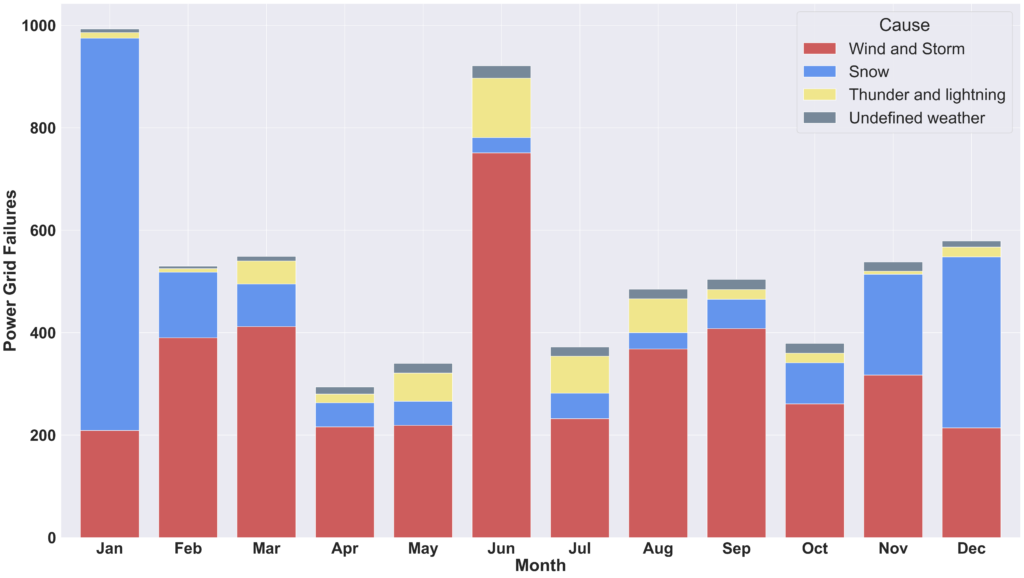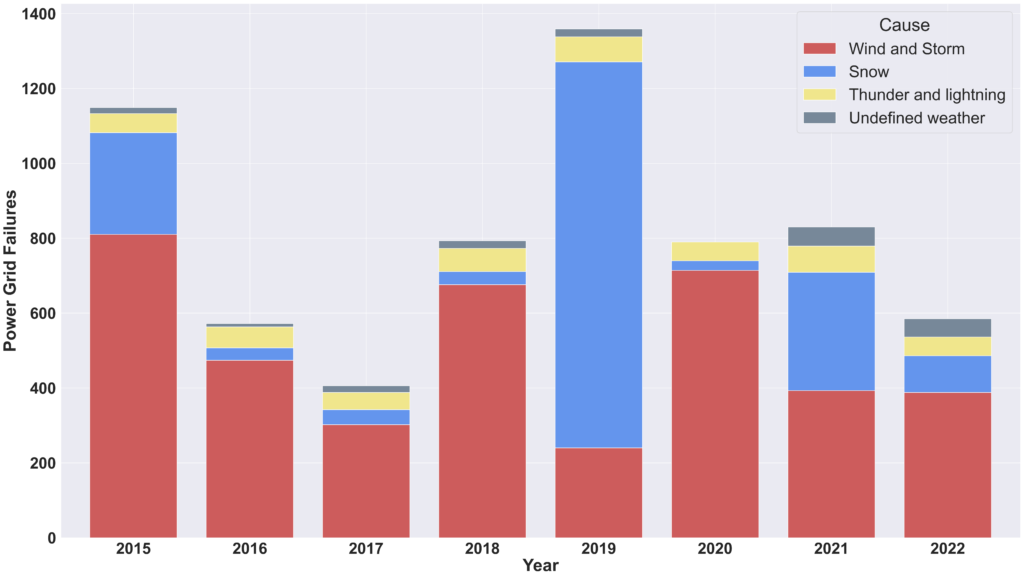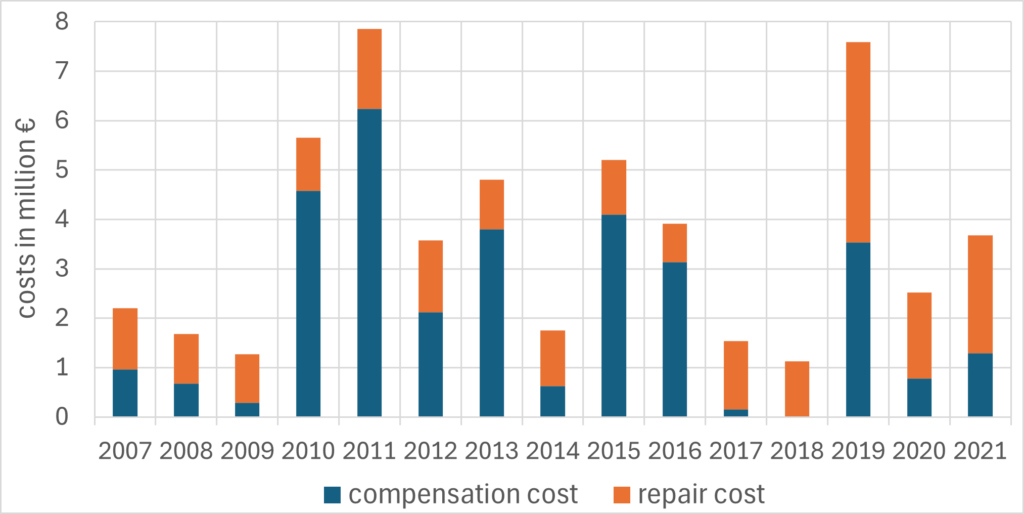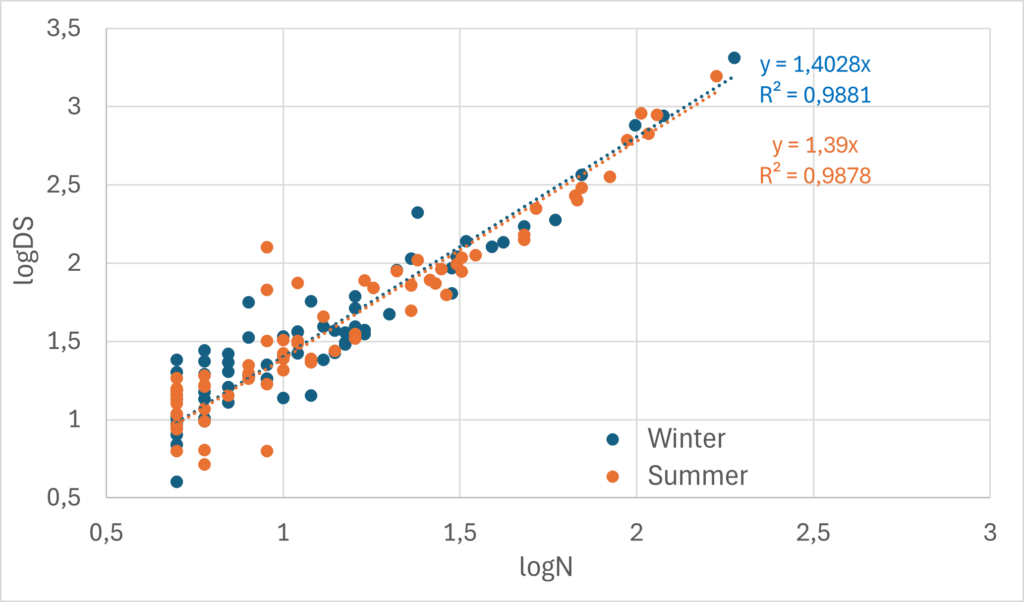Traditionally in Finland windstorms and snow loads have been the principal causes of failures in electricity distribution networks. Based on the detailed fault analysis of a power distribution we find that winter conditions do not seem to cause more cost than adverse weather in summer. Fault duration seems to be the critical factor in winter, whereas the number of faults per event is the prime factor in summer.
SEBASTIAAN VAN KOOTEN#, ILONA LÁNG-RITTER, ADRIAAN PERRELS
Finnish Meteorological Institute
#) Left FMI after the writing of the first version of the manuscript
Resiliency challenges in an electricity network. A significant part of the Finnish medium-voltage and low-voltage electricity distribution network outside built-up areas consists of overhead lines, which are prone to failures due to various hazardous weather conditions, such as windstorms, heavy snow loads, and lightning. In most cases, the eventual fault is caused by falling trees (or large branches) (Campbell, 2012). In the background can play complex interactions, which can either moderate or aggravate the fault risk level (see next section). Climate change has been regarded as having the potential of increasing the number of failures in the power network, e.g. owing to retreat in ground frost and occasionally larger snow loads (Haakana et al. 2023, Perrels et al. 2022).

In the Nordic collaborative study on climate changed induced risks of natural hazards for linear infrastructure (NordicLink) FMI focuses on a study of the underlying factors of faults in power lines owing to adverse weather conditions, and also assesses the sensitivity of costs to hazard characteristics and to response approaches. FMI cooperates with the electricity network company Järvi-Suomen Energia (JSE; a subsidiary of Suur-Savon Sähkö). We show a few main characteristics of the occurrence of power line failures, and subsequently discuss underlying factors for costs of power line disruptions.
Occurrence of failures. FMI obtained detailed powerline fault data, fault cost data, and network location data for the years 2015–2022 from JSE. These data were combined with weather observation data for the same area (South Savo), as well as with land-use and vegetation data from the same area. Figure 1 represents the distribution of power grid failures over the months in the JSE network. The failures are divided by their cause, of which wind- (56 %) and snow-related causes (34 %) dominate the statistics. Lightning caused around 6 % and other weather events 4 % of all failures. The large number of failures in January relates to snow loads, often combined with strong winds. In the period 2015–2022 there were several significant snow load events in January. The peak in June is mainly caused by windstorms. Presumably, the absence of frozen soil and achievement of full foliage in June contributes to the more dominant position of strong wind as a hazard factor. Effects of snow loads may culminate with delay into (partial) tree collapse, sometimes assisted by strong winds, hence cause attribution to snow load during the summer months (Fig. 1) is not an error. The monthly pattern of faults for the period 2015–2022 for the JSE service area differs from the national pattern (Haakana et al. 2023) with the latter having highest scores in the period November – January and elevated levels in period June – August. It is not directly clear what are the causes for the differences. The fairly short period (2015–2022) may also mean that it just happens to differ more over these particular years, but may not so much for a longer period.
In addition to the prime causes of strong winds and snow loads various other factors can significantly affect fault occurrence in overhead lines, such as the extent of frost in the ground (December – March), average tree height in the vicinity of the power lines, and cumulated damage prior to an extreme weather event. The implication is that a time series of weather-related power line fault characteristics in terms of fault duration and number of affected customers seem quite erratic. So, having some understanding of drivers of merely fault occurrence as such, may not be sufficient to understand the resulting cost patterns. An additional factor is the strategy of JSE and other Finnish power distribution companies to change a part of the overhead cables into underground cables. So far the growth in underground cabling by JSE since 2015 does not seem to show in the annual fault data (Fig. 2).

Cost patterns of failures. Figure 3 summarizes the annual cost owing to weather-related faults incurred by JSE from 2007 to 2021. For interruptions lasting longer than 12 hours clients are entitled to compensation, with the level of compensation depending on the duration class (12–24h; 24–72h; 72–120h; 120h or more) and annual electricity consumption. In addition, an electricity company incurs cost of repair. By increasing the repair effort compensation cost can be reduced to some extent, if this leads to shorter disconnect times. The challenge is to plan this carefully, inter alia by using detailed short term weather forecasts and nowcasting. When comparing figures 2 and 3 it gets obvious that the correlation between annual number of faults and the costs of repair and compensation is not very strong.

Not only the total costs vary significantly from year to year, but also the share of compensation cost in the total cost varies considerably over time. Next to cost of the electricity distribution company also the customers incur cost, which are partly neutralized by the compensation received from the distribution company. In contrast to the distribution company customers incur also non-monetary cost (i.e. welfare cost). The customers’ welfare costs of non-delivered electricity are notable (e.g. Nurmi et al. 2019), but are not directly comparable to the monetary cost presented here. The NordicLink project does distinguish between these cost notions, but its discussion goes beyond the scope of this article.
The assessment of the disruption risks in the NordicLink project follows a two-tier approach. First, we analyse the relation between the number and duration of faults by means of meteorological, environmental, and land use data. Subsequently, we analyse the relation between the duration and number of faults per event and the resulting costs, distinguished by repair costs and compensations to customers. In this respect it is important to understand how the sum of the durations of faults (disconnections) by weather event develops in relation to the number of faults per weather event, while distinguishing by cause (strong wind or snow load) and by season (winter or summer). Figure 4 presents the relationship between these variables (both in logarithmic form; for windstorms). Over the period 2015–2022 the total fault duration per windstorm seems to be almost equally sensitive to the number of faults in winter and summer. The graph for snow loads (not shown) is quite similar. Interestingly, the largest spread in durations is found for medium to smaller events (1.5 corresponds to 32 faults in one event). During holiday periods staff availability may be limited and hence durations may sometimes turn out to be higher than expected. The graph also suggests that for very serious events (> 100 faults) the pace of growth of duration may increase, Yet, the number of observations is too low to confirm that.

The analyses are not yet completed, but the findings so far indicate that it is hard to reduce the costs of weather induced faults substantially, unless one is prepared to invest massively in prevention. It remains to be seen whether that would pay off at macro-economic level, though it might be justifiable on the base of welfare cost. Nonetheless, moderate improvements in operational preparedness and repair planning could produce some savings.
Acknowledgements: The article is based on the NordicLink project funded by Nordforsk under grant agreement 98335. The authors thank the anonymous reviewers for their helpful comments on the draft version.
References
Campbell, R. J., 2012: Weather-Related Power Outages and Electric System Resiliency. Congressional Research Service (CRS), Publication Date: August 1, 2012, Last accessed 8 September 2022, url: https://sgp.fas.org/crs/misc/R42696.pdf.
Haakana, J., Haapaniemi, J., and Lassila, J., 2023: Energy storage as part of electricity distribution asset management. 2023 19th International Conference on the European Energy Market (EEM), Lappeenranta, Finland, 2023, pp. 1-6, http://dx.doi.org/10.1109/EEM58374.2023.10161901.
Nurmi, V., K. Pilli-Sihvola, H. Gregow, A. Perrels, 2019: Over-adaptation to Climate Change? The case of the 2013 Finnish Electricity Market Act, Economics of Disasters and Climate Change, 3(2), 161–190, https://doi.org/10.1007/s41885-018-0038-1.
Perrels, A. et al., 2022: Kustannusarviointi ilmastonmuutokseen liittyvästä toimimattomuudesta (KUITTI), Valtioneuvoston selvitys- ja tutkimustoiminnan julkaisusarja 2022:37, 159 pp, https://julkaisut.valtioneuvosto.fi/bitstream/handle/10024/164032/VNTEAS_2022_37.pdf?sequence=1&isAllowed=y
HOW TO CITE THIS ARTICLE:
Van Kooten S., I. Láng-Ritter, A. Perrels, 2024: Are natural hazard-induced costs of power line failures inevitable?, FMI’s Clim. Bull. Res. Lett., [preprint], https://doi.org/10.35614/ISSN-2341-6408-IK-2024-03-RL
CITATION INFORMATION:
Authors: Sebastiaan van Kooten, Ilona Láng-Ritter, Adriaan Perrels
Received: December 21, 2022
Accepted: February 22, 2024
First online: March 21, 2024
Published: coming, Spring 2024
Journal: FMI’s Climate Bulletin Research Letters
Volume: 6
Issue: 1
Pages: X-X
DOI: https://doi.org/10.35614/ISSN-2341-6408-IK-2024-03-RL
Header image: Adobe Stock




